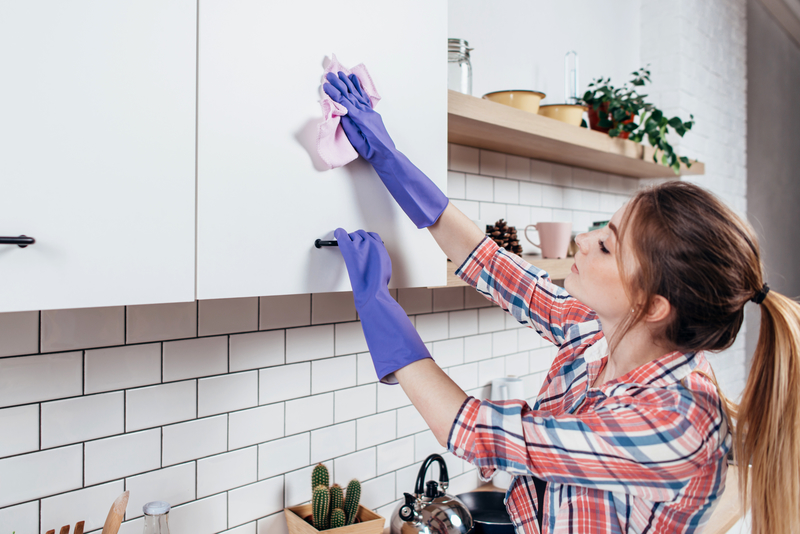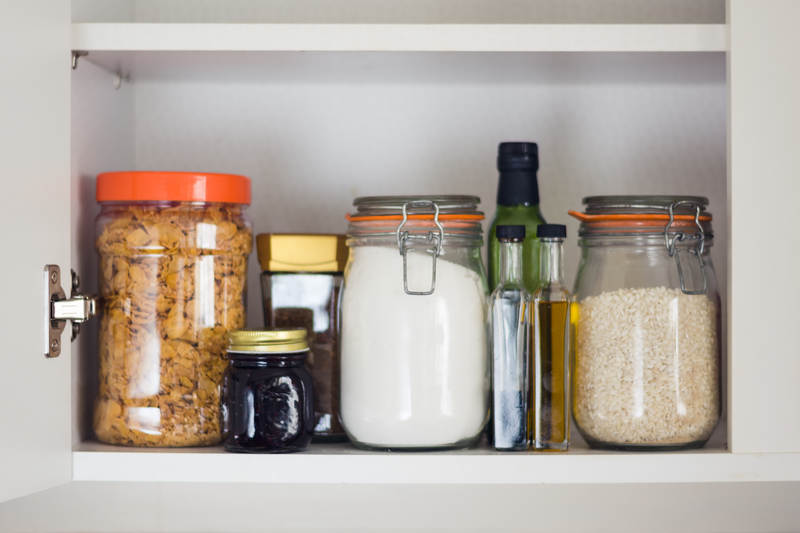How To Keep Your Kitchen Cabinets Clean

Whether your kitchen cabinets are new or old, at some point you’re going to have to deep clean them to keep them in tip-top shape. Our cabinets hold food, appliances and dishes, which can get them dirty very quickly. Oil and grease can make cleaning them even more difficult, and it may be tempting to use harsh chemicals on them. However, it’s important to use the right cleaning agents to prevent damaging the finish on your cabinets. Find out how you can get the tough stains out of your kitchen cabinets with this guide!
Cleaning The Exterior of Cabinets
Our kitchen cabinets are one of the first things that gets dirty and messy from food spills, appliances and overall disorder. While it’s completely normal to have a few messes here and there, it’s important to clean both the exterior and interior of your cabinets to keep these spills from damaging the finish and structure of the cabinets. For starters, the exterior of the cabinets often has the stickiest handprints, dirt and grease latched onto them, making them an eyesore and a health risk. Bacteria like salmonella can grow on dirty handles and knobs, leaving your family at risk for illness. For this reason, start your cleaning with the outside of the cabinets before making your way inside. Most cabinets made of laminate, wood, plastic and vinyl can be cleaned with a simple solution of dish soap and warm water. Dish soap is a fabulous degreaser and can easily remove tough buildup and stickiness from your cabinets. You can even use an all-purpose cleaner on your cabinets, as well, but make sure to test out both cleaning options on a hidden spot on the cabinets to make sure that they won’t damage your cabinets. Try your solution somewhere hidden rather than accidentally staining the exterior where it is obvious to the naked eye. Once you’ve tested the cabinets, start at the top cabinet and make your way down. It’s best practice to spray the cleaning solution onto a rag to clean the exterior, including knobs and handles. Rinse the exterior again with a wet rag and then use a dry rag to remove any water that is remaining. Water that is left on the exterior of cabinets can actually damage and discolor them, so it’s essential to dry them off after a good clean.
Cleaning The Inside of Cabinets
After cleaning the exterior of your cabinets, you can then begin the deep clean within them. The process of cleaning the interior is similar to cleaning the exterior, but with a few added tasks. Start by removing all food and appliances within each cabinet, and if your shelf lining is damaged, remove that, too. Most cabinets will have small amounts of food crumbs and residue in them, so you most likely will need to vacuum that out before you can start cleaning. From there, you can start wiping down each cabinet with warm water and a mild detergent to break through sticky spills and caked on grease. Once you’re finished, rinse each cabinet one more time with a damp cloth, without the cleaner, and then wipe dry with an additional rag. The interior of cabinets can become discolored or damaged if you leave leftover water on them, so make sure to wipe them dry after cleaning them.
Some grease spills can be so thick and hard on cabinets that it’s nearly impossible to remove them. In this case, you may need to invest in an orange oil cleaner that you spray on the spill and let sit for a few minutes. Murphy’s Oil Soap is a great cleaning agent that cuts through grime and grease while leaving your cabinets sparking clean. This will usually break apart the grease, but if that doesn’t work, try scrubbing the area with a soft-bristled toothbrush topped with a paste made of baking soda and water. This is another easy way to clean hard-to-remove residue from cabinets without damaging them.
How Often Should You Deep Clean?
Deep cleaning your kitchen cabinets isn’t always a fun experience, and it can be extremely strenuous. To avoid multiple deep cleanings throughout the year, try to clean up spills as soon as they happen so that they don’t have the chance to harden. The longer spills sit on or in your cabinets, the more likely it will be that they become hard-to-remove messes. Dust your cabinets every two weeks with a rag or standard duster to clean up minor spills and keep your cabinets from becoming dirty. This will help avoid deep cleanings later on as it will keep the cabinets and the food within them free of dirt. It’s also a good idea to wipe down dusty cans and food containers with warm water and dish soap, then dry them thoroughly. Food inside of your cabinets are a major contributor to sticky spills, so wiping them down every once in a while will help keep your cabinets from getting dirty. If you decide to use a sponge or cleaning product like a Magic Eraser, test out a small part of your cabinets with it before cleaning the entire surface of your cabinets. Some products are known to scratch the finish on cabinets, so do your research before cleaning with anything other a rag. Lastly, avoid putting heat-making appliances in your cabinets, like toasters or coffee makers. The heat that these appliances produce can damage cabinet surfaces and create ugly stains. By following these tips, you will avoid messy cleanups and ensure that your cabinets are clean and germ-free.
Get Beautiful Kitchen Cabinets With Our Help!
At Summit Cabinet Coatings, we offer a variety of options to create the kitchen cabinets of your dreams. Our finishes are second-to-none and are easy to clean, which will make your annual deep cleaning project much easier to do. If you’re in the market to update your kitchen cabinets, call our office today at (970) 282-9856 for a FREE estimate on your next cabinet project!